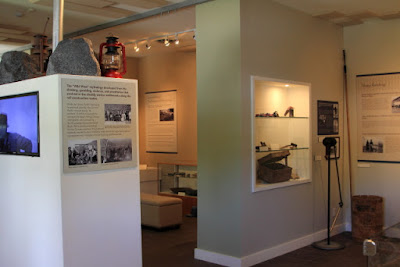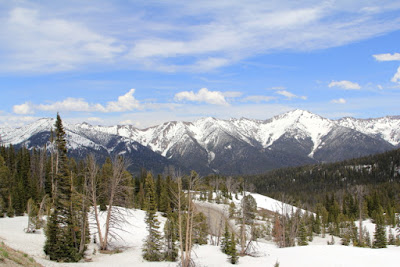Friday, July 7, 2017
RonnieAdventure #0263 - Sun Valley and Land of the Yankee Fork, Idaho
When most people think of Sun Valley (Idaho), they think of snow skiing. When most people think of snow skiing, they think of Warren Miller. Warren Miller has probably done more to promote the sport of snow skiing than any other person in the world.
Miller started his career in Sun Valley working as a ski instructor and other odd jobs to support his skiing habit. In 1946 he was living a teardrop trailer in the parking lot of the Sun Valley Ski Resort when he earned enough money to purchase an 8 mm camera so that he and a friend could take movies of each other skiing. He later rented an unheated garage for $5 per month and then charged other skiers $0.50 per night to pitch their sleeping bags on the floor. One of his renters was Edward Scott, who later invented the lightweight aluminum ski pole.
Miller's narrated 8 mm movies, along with his dry sense of humor, were a hit with his friends; so in 1949 it occurred to him that he might be able to turn his movie hobby into a full-time business. Each year he started making a full-length movie and then the next year during the ski season he traveled around the country showing his movie (for a small fee) in rented halls and theaters (usually with borrowed money). His shows were typically in towns near a ski resort so that he could film the next year's footage during the day and show his movie in the evening. I was fortunate to see many of his early movies that he personally narrated.
In the 1980s his movie company was sold to Time, Inc, which sold the business to Bonnier Corporation 2007, which was acquired by Active Interest Media in 2013. The company still produces a new ski movie each year.
One of the first chairlifts in the world was built in Sun Valley in 1939 by Union Pacific Railroad Engineers to promote tourism. Some of the early chairlift towers have been preserved and can be found in Sun Valley and the neighboring town of Katchum.
The Ski Museum in Katchum is currently closed and will be reopened at a later date as part of the Sun Valley Museum of History, which will also include historic Olympic memorabilia. Currently, the museum contains primarily a history of early settlement in the Sun Valley area.
One of the more famous residents of Katchum was Ernest Hemingway. He died in his home on July 2, 1961 and is buried in the Katchum cemetery along with a number of his family members. There is also a Hemingway memorial in Sun Valley overlooking Trail Creek.
A few miles past the Hemingway memorial, the Trail Creek Road was still closed from the heavy winter snows that they had this year.
Also on display in the area is the first bi-polar generator installed in the 1880s to provide electricity for the Ketchum Smelter. The generator was powered by a waterwheel and rated at 20 kilowatts, 125 volts and 160 amperes.
Located next to our campground was small park with some interesting modern art pieces.
Traveling north from Sun Valley through the Sawtooth National Forest is one of the most beautiful drive that I have taken in a long time.
The road goes up over Galena Summit and about a mile from the summit is the Bethine and Frank Church Overlook. From the overlook it is possible to see the headwaters of the Salmon River.
After leaving the summit, the road descends into a valley and then follows the Salmon River to the small community of Stanley. We even saw a few antelope next to the road on the trip!
The historic ranger's station in Stanley is located on a site known as "Bear's Ploughed Field." The historic ranger station in now the Sawtooth Interpretive and Historical Association Museum.
In 1824 when the Hudson Bay Company's trappers arrived in the area, form a distance it appeared as though someone had "ploughed the field." However, upon closer inspection they "found a large piece of ground...dug up and turned over [by] no less than nine black and grizzly bears at work, rooting away, eating camas, onions, and wild celery."
Stanley is the starting point for the Salmon River Scenic Byway, which runs east along the Salmon river all of the way to the Montana border.
Following the Byway, and just before reaching the historic site of Sunbeam, adjacent to the highway are some interesting hot springs and a bathhouse completed in 1937 by men from the Clayton CCC Camp.
Early explorers from the Hudson Bay Company first discovered the hot springs in 1824 and described camping "at the boiling fountain." They did not camp long at this location, however, because the superheated water reaching the earth's surface along fault fracture lines contained a high concentration sulfur. When the sulfur mixed with hydrogen in the air it produced a "rotten egg" smell that is common with many hot sprints.
One of the unique features about the bath house is the availability of hot and cold water.
Water directly from the springs was too hot to use for bathing, so a pipe was constructed from the spring through the river before reaching the bathhouse. The cold river water cooled the hot spring water to a usable temperature.
In later years Barzilla Clark attempted to raise chickens at the site, but the chicken operation failed; so Barzilla went into politics and became Governor of Idaho,
The Sunbeam Dam and hydroelectric plant was constructed at the junction of Idaho State Road 75 and the Custer Motor Way in 1909 to provide power for the mines at Custer and Bonanza. However, the dam prohibited Salmon from swimming upstream to spawn, so when the gold mines played out the dam was drained and the adjacent hillside was blasted away so that Salmon could migrate upstream once again.
Clayton is a few miles up the road, so we drove up to Clayton and then back to Sunbeam just so that I could finish the trip that I had to cancel last year when were were turned back by a forest fire.
The Custer Motor Way leads up the canyon to the old Yankee Fork Mining area and to the ghost towns of Bonanza and Custer.
There are a few remaining buildings in Bonanza that are in poor condition and most of them will probably not remain standing for many more years.
The Bonanza cemetery is also poor condition and in need of some restoration if it is to survive for many more years.
Between Bonanza and Custer there is an old dredge that is being maintained by a group of volunteers and they offer self-guided tours of the facility throughout the day during the summer months. The problem with dredge mining is that it leaves the stream-bed in an unsightly condition.
The ghost town of Custer is maintained by the Idaho Department of Parks and Recreation (and a lot of volunteers).
The Custer Cemetery is better maintained than the Bonanza Cemetery and it is interesting to read the grave markers.
We needed to have some work done on the pickup, so we decided to return to Utah for a few days. I really dislike traveling on the Interstate, but it did allow us to make the return trip in one day while pulling our trailer!
Subscribe to:
Post Comments (Atom)








































































No comments:
Post a Comment